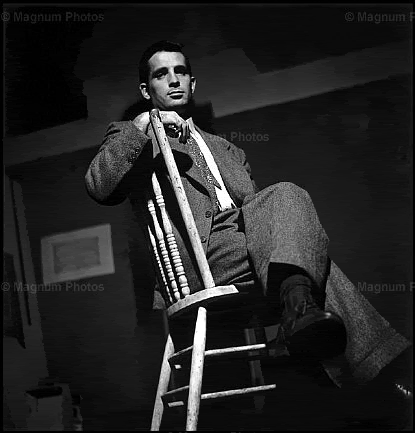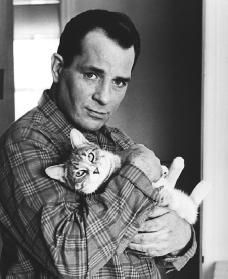Jack Kerouac
Born: March 12, 1922
Place of Birth: Lowell, Massachusetts
Died: October 21, 1969
Place of Death: St. Petersburg, Florida
Texts from Levi Asher - Literary Kicks
Excerpted by permission of copyright holder
Jack Kerouac was born Jean-Louis Kerouac, a French-Canadian child in working-class Lowell, Massachusetts. Ti Jean spoke a local dialect of French called joual before he learned English. The youngest of three children, he was heartbroken when his older brother Gerard died of rheumatic fever at the age of nine.
Ti Jean was an intense and serious child, devoted to Memere (his mother) and constantly forming important friendships with other boys, as he would continue to do throughout his life. He was driven to create stories from a young age, inspired first by the mysterious radio show 'The Shadow,' and later by the fervid novels of Thomas Wolfe, the writer he would model himself after.
Lowell had once thrived as the center of New England's textile industry, but by the time of Kerouac's birth it had begun to sink into poverty. Kerouac's father, a printer and well-known local businessman, began to suffer financial difficulties, and started gambling in the hope of restoring prosperity to the household. Young Jack hoped to save the family himself by winning a football scholarship to college and entering the insurance business. He was a star back on his high school team and won some miraculous victories, securing himself a scholarship to Columbia University in New York. His parents followed him there, settling in Ozone Park, Queens.
Things went wrong at Columbia. Kerouac fought with the football coach, who refused to let him play. His father lost his business and sank rapidly into alcoholic helplessness, and young Jack, disillusioned and confused, dropped out of Columbia, bitterly disappointing the father who had so recently disappointed him. He tried and failed to fit in with the military (World War II had begun) and ended up sailing with the Merchant Marine. When he wasn't sailing, he was hanging around New York with a crowd his parents did not approve of: depraved young Columbia students Allen Ginsberg and Lucien Carr, a strange but brilliant older downtown friend named William S. Burroughs, and a joyful street cowboy from Denver named Neal Cassady.
Kerouac had already begun writing a novel, stylistically reminiscent of Thomas Wolfe, about the torments he was suffering as he tried to balance his wild city life with his old-world family values. His friends loved the manuscript, and Ginsberg asked his Columbia professors to help find a publisher for it. It would become Kerouac's first and most conventional novel, The Town and the City, 'which earned him respect and some recognition as a writer, although it did not make him famous.
It would be a long time before he would be published again. He had taken some amazing cross-country trips with Neal Cassady while working on his novel, and in his attempt to write about these trips he had begun experimenting with freer forms of writing, partly inspired by the unpretentious, spontaneous prose he found in Neal Cassady's letters. He decided to write about his cross-country trips exactly as they had happened, without pausing to edit, fictionalize or even think. He presented the resulting manuscript to his editor on a single long roll of unbroken paper, but the editor did not share his enthusiasm and the relationship was broken. Kerouac would suffer seven years of rejection before 'On The Road' would be published.
He spent the early 1950's writing one unpublished novel after another, carrying them around in a rucksack as he roamed back and forth across the country. He followed Ginsberg and Cassady to Berkeley and San Francisco, where he became close friends with the young Zen poet Gary Snyder. He found enlightenment through the Buddhist religion and tried to follow Snyder's lead in communing with nature. His excellent novel 'The Dharma Bums' describes a joyous mountain climbing trip he and Snyder went on in Yosemite in 1955, and captures the tentative, sometimes comic steps he and his friends were taking towards spiritual realization.]
His fellow starving writers were beginning to attract fame as the 'Beat Generation 'a label Kerouac had invented years earlier during a conversation with fellow novelist John Clellon Holmes. Ginsberg and Snyder became underground celebrities in 1955 after the Six Gallery poetry reading in San Francisco. Since they and many of their friends regularly referred to Kerouac as the most talented writer among them, publishers began to express interest in the forlorn, unwanted manuscripts he carried in his rucksack wherever he went. 'On The Road' was finally published in 1957, and when it became a tremendous popular success Kerouac did not know how to react. Embittered by years of rejection, he was suddenly expected to snap to and play the part of Young Beat Icon for the public. He was older and sadder than everyone expected him to be, and probably far more intelligent as well. Literary critics, objecting to the Beat 'fad,' refused to take Kerouac seriously as a writer and began to ridicule his work, hurting him tremendously. Certainly the Beat Generation was a fad, Kerouac knew, but his own writing was not.
His sudden celebrity was probably the worst thing that could have happened to him, because his moral and spiritual decline in the next few years was shocking. Trying to live up to the wild image he'd presented in 'On The Road,' he developed a severe drinking habit that dimmed his natural brightness and aged him prematurely. His Buddhism failed him, or he failed it. He could not resist a drinking binge, and his friends began viewing him as needy and unstable. He published many books during these years, but most had been written earlier, during the early 50's when he could not find a publisher. He kept busy, appearing on TV shows, writing magazine articles and recording three spoken-word albums, but his momentum as a serious writer had been completely disrupted.
Like Kurt Cobain, another counter-culture celebrity who seemed to be truly (as opposed to fashionably) miserable, Kerouac expressed his unhappiness nakedly in his art and was not taken seriously. In 1961 he tried to break his drinking habit and rediscover his writing talents with a solitary nature retreat in Big Sur. Instead, the vast nature around him creeped him out and he returned to San Francisco to drink himself into oblivion. He was cracking up, and he laid out the entire chilling experience in his last great novel, 'Big Sur.'
Defeated and lonesome, he left California to live with his mother in Long Island, and would not stray from his mother for the rest of his life. He would continue to publish, and remained mentally alert and aware (though always drunken). But his works after 'Big Sur' displayed a disconnected soul, a human being sadly lost in his own curmudgeonly illusions.
Despite the 'beatnik' stereotype, Kerouac was a political conservative, especially when under the influence of his Catholic mother. As the beatniks of the 1950's began to yield their spotlight to the hippies of the 1960's, Jack took pleasure in standing against everything the hippies stood for. He supported the Vietnam War and became friendly with William F. Buckley.
Living alone with his mother in Northport, Long Island, Kerouac developed a fascinating set of habits. He stayed in his house most of the time and carried on a lifelong game of 'baseball' with a deck of playing cards. His drink of choice was a jug of the kind of cheap, sweet wine, Tokay or Thunderbird, usually preferred by winos. He became increasingly devoted to Catholicism, but his unusual Buddhist-tinged brand of Catholicism would hardly have met with the approval of the Pope.
Through his first forty years Kerouac had failed to sustain a long-term romantic relationship with a woman, though he often fell in love. He'd married twice, to Edie Parker and Joan Haverty, but both marriages had ended within months. In the mid-1960's he married again, but this time to a maternalistic and older childhood acquaintance from small-town Lowell, Stella Sampas, who he hoped would help around the house as his mother entered old age.
He moved back to Lowell with Stella and his mother, and then moved again with them to St. Petersburg, Florida. His health destroyed by drinking, he died at home in 1969. He was 47 years old.



 Reply With Quote
Reply With Quote










